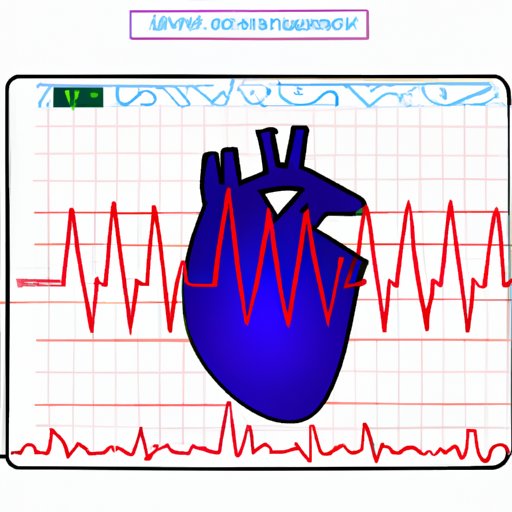Introduction
A heart monitor, also known as an electrocardiogram (ECG) machine, is a device used to measure the electrical activity of the heart. It records the electrical signals that are generated when the heart beats and provides information about the health of the heart. The heart monitor can be used in a variety of settings, such as a doctor’s office, hospital, or even at home.
To understand how a heart monitor works, it is important to understand the anatomy and physiology of the heart. The heart is made up of four chambers: the left and right atria and the left and right ventricles. The walls of the heart contain muscle fibers that contract and relax to pump blood throughout the body. The electrical impulses that cause these contractions can be measured using electrodes placed on the chest and limbs.
Types of Heart Monitors
There are several different types of heart monitors available. The most common type is the Holter monitor, which is worn for 24 hours or more and records the electrical activity of the heart over a period of time. Another type is the event recorder, which records only when triggered by an event, such as a palpitation or skipped beat. Ambulatory monitors are also available, which are worn continuously for an extended period of time. Finally, there are implantable loop recorders, which are implanted under the skin and continuously monitor the electrical activity of the heart.
Each type of heart monitor has its own features and benefits. Holter monitors are useful for detecting arrhythmias, or abnormal heart rhythms, over a long period of time. Event recorders can help diagnose heart problems that occur sporadically. Ambulatory monitors are useful for monitoring the heart during physical activity, and implantable loop recorders are useful for detecting arrhythmias over a long period of time.

Setting Up and Interpreting Results from a Heart Monitor
The process of setting up a heart monitor depends on the type of device being used. For a Holter monitor, electrodes will need to be attached to the chest and limbs and connected to the device. For an event recorder, the patient may wear a belt with electrodes attached to it. For ambulatory monitors, the patient will wear a device similar to a pager. Implantable loop recorders require a surgical procedure to implant the device under the skin.
Once the heart monitor is set up, the results can be interpreted. The data from the heart monitor is displayed as a graph called an electrocardiogram (ECG). The ECG shows the electrical activity of the heart over time, including the rate and rhythm of the heartbeat. This data can then be used to diagnose heart conditions or to monitor the effectiveness of treatments.

Risks Associated with Using a Heart Monitor
Although heart monitors are generally safe to use, there are some potential risks associated with them. The most common risk is skin irritation or allergic reaction due to the adhesive used to attach the electrodes. Additionally, patients with pacemakers or other implanted devices should not use certain types of heart monitors.
To minimize the risks associated with using a heart monitor, it is important to follow the instructions provided by the manufacturer carefully. Additionally, patients should inform their doctor if they have any allergies or medical conditions that could be affected by the use of a heart monitor.

Comparison of Various Types of Heart Monitoring Technology
The various types of heart monitoring technology each have their own advantages and disadvantages. Holter monitors are the most widely used type, but they are bulky and can be uncomfortable to wear for long periods of time. Event recorders are less intrusive, but they only capture data when triggered. Ambulatory monitors are useful for monitoring physical activity, but they can be expensive. Implantable loop recorders provide continuous monitoring, but they require a surgical procedure.
Impact of Heart Monitors on Sports Performance
Heart monitors are becoming increasingly popular among athletes, as they can help to improve performance. They can be used to track heart rate, breathing rate, and other physiological parameters, allowing athletes to adjust their training accordingly. Additionally, they can be used to monitor fatigue levels during competitions and help athletes to avoid overtraining.
However, there are some potential drawbacks to using heart monitors in sports. Some athletes may become overly reliant on the data, leading to an unhealthy reliance on technology. Additionally, some athletes may feel pressure to push themselves too hard in order to reach goals set by the device.
Conclusion
Heart monitors are useful devices that can provide valuable information about the health of the heart. They come in a variety of types, with each type having its own features and benefits. Setting up and interpreting results from a heart monitor is relatively straightforward, although there are some potential risks associated with their use. Additionally, heart monitors can be used to improve sports performance, although there are potential drawbacks to using them as well.
In summary, heart monitors can be a useful tool for diagnosing and monitoring heart conditions. However, it is important to understand the risks associated with their use and to take safety precautions when using them. Additionally, athletes should be aware of the potential drawbacks of relying too heavily on the data provided by heart monitors.
(Note: Is this article not meeting your expectations? Do you have knowledge or insights to share? Unlock new opportunities and expand your reach by joining our authors team. Click Registration to join us and share your expertise with our readers.)
